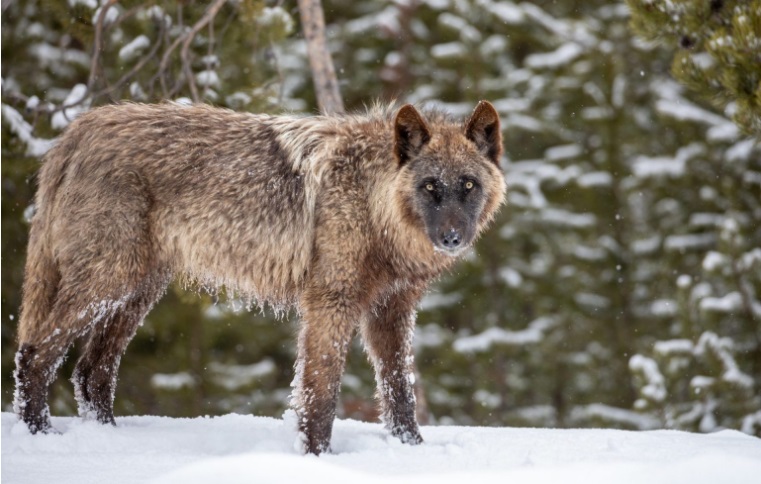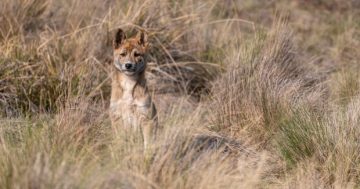
Wildlife photographer Ian Brown says the dingo lives in a conservation grey area where they’ll die from 1080 poison baits intended for foxes and wild dogs. Photo: Snowy Brumby Photography Adventures with Michelle and Ian.
Kosciuszko National Park’s long and slow post-fire convalescence may be under way, but the NSW Government’s actions in stemming wild dog populations to save recovering native wildlife is a case of baiting the hand that feeds it.
This is according to researchers who, for at least two decades, have studied dingo populations throughout Australia.
Snowy Mountains wilderness photographer Ian Brown said history has been so damning for dingoes that there’s no safe place for them to live.
“The lingering ramifications of inaccurate beliefs, combined with inter-generationally-perpetuated negative images of the dingo as a cowardly and savage killer of stock animals, has resulted in a skewed public perception which has ensured a lack of interest in their conservation as a unique native species,” he said.
Ian said that leaves the dingo in a precarious grey area, where even in the perceived safety of national and state parks they’ll die from 1080 poison baits intended for foxes and wild dogs.

The landscape and ecology of Yellowstone National Park has been transformed since the reintroduction of wolves in 1995. Photo: yellowstone.org
Dingo Conservation Solutions NENSW president Zac Forster said if there was such a thing as a wild domestic dog, they could survive for generations by themselves, living independent of man.
“This is not the reality, therefore the term ‘wild dog’ is a misrepresentation of what the domestic dog is actually capable of,” he said.
“If you look anywhere around the world there are no populations of domestic dogs existing in the wild living independently of man.
“Even a hunting dog lost in the bush might have the ability – through its hunting propensities – to survive for his generation until he dies, but people get this romantic idea a dog’s going to jump the fence with its partner, go live in the bush, have pups and stay out there – it just doesn’t happen.”
Zac said the domestic dog lineage doesn’t have the necessary inbuilt survival instincts to form persisting populations in the bush.
“They might survive a generation, but when it comes to raising pups they have to dig a den, then educate the pups on situations to avoid and those to exploit, how to survive other dingoes, snakes, wedge tailed eagles and humans,” he explained.
“Female dingoes have had tens of thousands of years of evolution to be imbued with that knowledge and those instincts to live and procreate in the wild.”
A recent UNSW study found virtually no feral dogs across the continent and very little evidence of interbreeding between dingoes (Canis dingo) and domestic dogs (Canis familiaris), bringing into question the widely used term “wild dog”.
Study co-author, UNSW conservation biologist Dr Kylie Cairns said it was important governments, wildlife managers and agriculture industry groups use the name “dingo” to describe these wild canines because that’s what they are.
“And we need to have a discussion about whether killing a native animal – which has been shown to have benefits for the ecosystem – is the best way to go about ecosystem recovery,” she said.
Researchers point to Yellowstone National Park in the US, and what has been achieved there since 14 Canadian grey wolves were reintroduced in 1995 – 70 years after the species been eradicated.
Zac said their disappearance disrupted food webs and the ecological balance, allowing populations of their natural prey – the elk – to multiply and consume increasing amounts of the natural habitat.
When wolves were brought back to the park, they not only quickly reduced elk numbers, but changed their behaviour patterns. The herbivores started to avoid valleys and gorges where they were easily hunted by predators. As a result, those areas began to regenerate, and species such as birds, beavers, mice and bears returned.
Plant life once again thrived along the riverbanks and erosion decreased significantly. The stabilisation of the riverbanks actually made the rivers and streams change course. Reintroduction of just a small population of wolves completely transformed the park’s landscape.
Zac said the loss of Australia’s largest land-based apex predator was no different, citing Sturt National Park as a pivotal empirical study.
“On one side of the dingo fence the landscape – where there are no dingoes – is more barren, because there are more roos overgrazing on the shrubs and grasses, destabilising the topsoil which then gets blown away, depleting the soil health. This overgrazing of the flora then allows foxes and feral cats to prey on unprotected smaller native species because their predator cover has been eaten by the roos.
“On the other side, where dingoes exist, the landscape is in an ecological balance because there are fewer roos and the dingoes regulate the numbers of feral species.”
He joins Ian Brown in saying the destruction of dingo populations in fire-impacted areas is disrupting the balance of the entire ecosystem.
“Last year the NSW Government conducted the largest aerial baiting campaign ever in the southern hemisphere, one million poison baits were dropped across 40,000 km of wildlife pathways in what was supposed to be a recovery program to save fire-affected native species,” he said.
“If you start this indiscriminate 1080 baiting you take the dingoes out. Straight away feral cats and foxes move in to fill the ecological niche.
“To me, 1080 baiting campaigns are one of the biggest ecological disasters in the history of this country, the effects of which are largely unknown at this point.”








